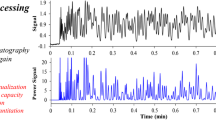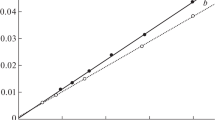Summary
Quantitation by peak area or height has been investigated for small peaks which are accompanied by a large neighbour of 100 or 1000 times greater size. The peaks were generated by a computer and evaluated with an integrator. The parameters varied were peak order, relative peak width, tailing, and resolution. First eluted small peaks were evaluated by vertical drop; for last eluted small peaks vertical drop and tangent skimming methods were compared.
It was found that the size of small peaks can be determined accurately if they precede the large one and if their height is used for quantitation. Under these conditions even poor resolution and tailing can be tolerated. However, if the peaks are truly Gaussian, the elution order is of minor importance. If the small peak is eluted after the large one the only recommendation is to achieve true baseline resolution if possible. The quantitation of narrow “rider” peaks is problematical.
The results are not only presented in tabulated form but representative peak pairs are also shown as an aid for the analyst. A real liquid chromatographic separation confirms the results.
Similar content being viewed by others
References
P. Ciccioli, A. Cecinato, E. Brancaleoni, M. Frattoni, A. Liberti, J. High Res. Chromatogr.15, 75 (1992).
J. A. Perry, J. D. Rateike, T. J. Szczerba, J. Chromatogr.389, 57 (1987).
T. D. Doyle, in “Chiral Separations by Liquid Chromatography”, S. Ahuja, Ed., American Chemical Society, Washington, DC, 1991, p. 27.
Impurities in New Drug Substances. European Commission, Directory-General III, Industry, Industrial affairs III: Consumer goods industries, Pharmaceuticals. Draft, Belgium, 1994.
L. R. Snyder, J. Chromatogr. Sci.10, 200 (1972).
V. R. Meyer, LC GC Int.7, 94 (1994).
V. R. Meyer, J. Chromatogr. Sci.33, 26 (1995).
J. A. Perry, J. Liquid Chromatogr.13, 1047 (1990).
R. J. Maggs, A. S. Mead in “Gas Chromatography 1970”, R. Stock, Ed., The Institute of Petroleum, London, 1971, p. 310.
W. Kipiniak, J. Chromatogr. Sci.19, 332 (1981).
E. L. Inman, H. J. Tenbarge, J. Chromatogr. Sci.26, 89 (1988).
Y. Hayashi, R. Matsuda, Anal. Chem.66, 2874 (1994).
J. Pörschmann, W. Engewald, in “Packings and Stationary Phases in Chromatographic Techniques”, K. K. Unger, Ed., Marcel Dekker, New York, 1990, p. 132.
M. Lämmerhofer, W. Lindner, Chirality6, 261 (1994).
J. P. Foley, J. G. Dorsey, J. Chromatogr. Sci.22, 40 (1984).
J. K. Strasters, in “Diode Array Detection in HPLC”, L. Huber, S. A. George, Eds. Marcel Dekker, New York, 1993, p. 127.
e.g. PeakFit By Jandel Scientific, 2591 Kerner Vlvd., San Rafael, CA 94901, USA.
R. Sedgewick, “Algorithms”, Addison-Wesley, Reading, 2nd. ed., 1988.
B. Weimann, Chromatographia7, 472 (1974).
Author information
Authors and Affiliations
Rights and permissions
About this article
Cite this article
Meyer, V.R. Quantitation of chromatographic peaks in the 0.1 to 1.0% range. Chromatographia 40, 15–22 (1995). https://doi.org/10.1007/BF02274601
Received:
Revised:
Accepted:
Issue Date:
DOI: https://doi.org/10.1007/BF02274601




